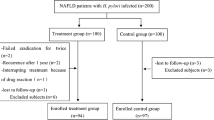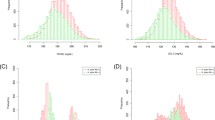Abstract
It is still unclear whether Helicobacter pylori infection is associated with risk factors for coronary artery disease. The aim of this study was to determine whether eradication of H. pylori infection affects serum lipid levels and C-reactive protein (CRP) levels. Seventy-eight patients who had H. pylori antigen positivity in their stools were enrolled. Clarithromycin, 1 g/day, amoxicillin, 2 g/day, and omeprazole, 40 mg/day, were given for 14 days. Serum total cholesterol (TC), high-density lipoprotein (HDL), low-density lipoprotein (LDL), triglyceride (TG), and CRP were measured at baseline and 8 weeks after therapy. According to H. pylori stool antigen study after 8 weeks, individuals in whom H. pylori was eradicated were recruited as group A and those in whom H. pylori was not eradicated formed group B. Group A comprised 57 patients, and group B 21 patients. Patients in group A comprised 32 women and 25 men and their ages ranged from 35 to 59 years. Patients in group B included 13 women and 8 men, aged 32–61 years. No significant difference in LDL, TC, or TG serum levels were found between group A and group B. Although CRP and HDL serum levels were found to be the same before and after treatment in group B, CRP levels were found to decrease and HDL levels to increase significantly in group A (P < 0.05). We conclude that H. pylori infection may affect lipid metabolism in a way that could increase the risk of atherosclerosis. Thus H. pylori infection is an independent risk factor for coronary artery disease.
Similar content being viewed by others
References
Roussos A, Philippou N, Gourgoulianis KI: Helicobacter pylori infection and respiratory diseases: a review. W J Gastroenterol 9(1):5–8, 2003
Laurila A, Bloigu A, Nayha S, Hassi J, Leinonen M, Saikku P: Association of H. pylori infection with elevated serum lipids. Atherosclerosis 142:207–210, 1999
Kinjo K, Sato H, Sato H, et al.: Prevalence of H. pylori infection and its link to coronary risk factors in Japanese patients with acute myocardial infarction. Circ J 66:805–810, 2002
Niemela S, Karttunen T, Korhonen T, Laara E, Karttunen R, Ikaheimo M, Kesaniemi YA: Could H. pylori infection increase the risk of coronary heart disease by modifying serum lipid concentrations? Heart 75:573–575, 1996
Cammaroat G, Pasceri V, Gasbarrini A, Gabarrini G: Helicobacter pylori is an aetiologic factor for ischaemic heart disease: the case against. Digest Liver Dis 32:65–68, 2000
Realdi G, Dore P M, Fastame L: Extradigestive manifestations of H. pylori infection: Fact and fiction. Dig Dis Sci 44:229–236, 1999
Patel P, Gasbarrini G, Pretolani S, Gasbarrini A, Franceshi F: Extradigestive diseases and H. pylori infection. Curr Opin Gastroenterol 13:52–55, 1997
Ekesbo R, Nilsson PM, Lindholm LH, Persson K, Wadstrom T: Combined seropositivity for H. pylori and C. pneumonia is associated with age, obesity and social factors. J Cardiovasc Risk 7:191–195, 2000
Mendall MA, Goggin PM, Molineaux N, et al.: Realation of H. pylori infection and coronary heart disease. Br Heart J 71:437–439, 1994
Pasceri V, Cammarota G, Patti G, et al. : Association of virulent H. pylori strains with ischemic heart disease. Circulation 71:1675–1679, 1998
Danesh J, Youngman L, Clark S, Parish S, Peto R, Collins R: H. pylori infection and early onset myocardial infection: Case–control and sibling pairs study. BMJ 319:1157–1162, 1999
Strachan DP, Mendall MA, Carrington D, et al.: Relation of H. pylori infection to 13–year mortality and incident ischemic heart disease in the Caerphilly prospective heart disease study. Circulation 98:1286–1290, 1998
Folsom AR, Nieto FJ, Sorlie P, Chambless LE, Graham DY: H. pylori seropositivity and coronary heart disease incidence: Atherosclerosis risk in communities (ARIC) study investigators. Circulation 98:845–850, 1998
Ridker PM, Danesh J, Youngman L, et al.: A prospective study of H. pylori seropositivity and the risk for future myocardial infarction among socioeconomically similar U.S. men. Ann Intern Med 135:184–188, 2001
Gallin JL, Kaye D, O’Leary WM: Serum lipid in infection. N Engl J Med 281:1081–1086, 1969
Alvarez C, Ramos A: Lipids, lipoproteins, and apoproteins in serum during infection. Clin Chem Res 32:142–145, 1986
Kerttula Y, Weber T: Serum lipids in pneumonia of different aetiology. Ann Clin Res 20:184–188, 1988
Grunfeld C, Gulli R, Moser AH, Gavin LA, Feingold KR: Effect of tumour necrosis factor administration in vivo on lipoprotein lipase activity in various tissues of the rat. J Lipid Res 30:579–585, 1989
Kaukoranta-Tolvanan SS, Teppo AM, Laitinen K, Saikku P, Linnavuori K, Leinonen M: Growth of C. pneumonia in cultured human peripheral blood mononuclear cells and induction of a cytokine response. Microb Pathog 21:215–221, 1996
Lopes-Virella MF: Interactions between bacterial lipopolysaccharide and serum lipoproteins and their possible role in coronary heart disease. Eur Heart J 14:118–124, 1993
Author information
Authors and Affiliations
Corresponding author
Rights and permissions
About this article
Cite this article
Kanbay, M., Gür, G., Arslan, H. et al. Does Eradication of Helicobacter pylori Infection Help Normalize Serum Lipid and CRP Levels?. Dig Dis Sci 50, 1228–1231 (2005). https://doi.org/10.1007/s10620-005-2764-9
Received:
Accepted:
Issue Date:
DOI: https://doi.org/10.1007/s10620-005-2764-9




